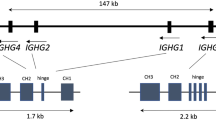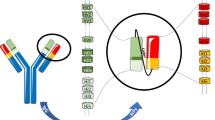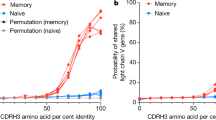Abstract
GENETIC polymorphism of the structural genes encoding the class-specific (heavy) polypeptide chains of the immunoglobulin (Ig) molecules provides a useful set of markers for elucidating the arrangement and expression of these genes. On the basis of various antigenic, physiochemical and biological properties, the immunoglobulins of the mouse have been divided into eight distinct classes, IgM, IgD, IgA, IgG1, IgG2a, IgG2b, IgG3 and IgE, with a specific structural gene determining the heavy chain (H) for each class. Previous studies have documented the existence of a genetic polymorphism for five of these H-chain genes1–3, with all the genes being closely linked constituting a heavy chain chromosome region. The most recent of these loci to be demonstrated (Ig-5, determining the δ chain)3 was detected by the reaction of alloantisera prepared against spleen cells from mice differing in both H–2 and allotype. These sera reacted with B lymphocytes of the appropriate allotype congenic strains, as assessed by either immunofluorescence, or cell surface iodination and polyacrylamide gel electrophoresis (PAGE). As most B lymphocytes express cell surface IgM as well as IgD (refs 4–6), we have further pursued these various approaches to identify Ig allotypes and have found a polymorphism of the heavy chain (μ) of murine IgM, a molecule found in pentameric form (19S) in serum, and in monomeric (8S) form on the surface of lymphocytes. This defines a locus, Ig-6, which encodes the μ chain of most mouse IgM immunoglobulin.
This is a preview of subscription content, access via your institution
Access options
Subscribe to this journal
Receive 51 print issues and online access
$199.00 per year
only $3.90 per issue
Buy this article
- Purchase on Springer Link
- Instant access to full article PDF
Prices may be subject to local taxes which are calculated during checkout
Similar content being viewed by others
References
Herzenberg, L. A., & Warner, N. L., in Regulation of the Antibody Response (ed. Cinader, B.), 322–348 (C. C. Thomas, Springfield, Illinois, 1968).
Herzenberg, L. A., McDevitt, H. O. & Herzenberg, L. A. A. Rev. Genet. 2, 209–244 (1968).
Goding, J. W., Warr, G. W. & Warner, N. L. Proc. natn. Acad. Sci. U.S.A. 73, 1305–1309 (1976).
Pernis, B., Brouet, J. C. & Seligmann, M., Eur. J. Immun. 4, 776–778 (1974).
Goding, J. W. & Layton, J. J. exp. Med. (in the press).
Abney, E. R., Hunter, I. R. & Parkhouse, R. M. E. Nature 259, 404–406 (1976).
Kessler, S. W. J. Immun. 115, 1617–1624 (1976).
Weigert, M., Potter, M. & Sachs, D. Immunogenetics 1, 511–523 (1975).
Herzenberg, L. A. et al. Cold. Spring. Harb. Symp. quant. Biol. 41 (in the press).
Author information
Authors and Affiliations
Rights and permissions
About this article
Cite this article
WARNER, N., GODING, J., GUTMAN, G. et al. Allotypes of mouse IgM immunoglobulin. Nature 265, 447–449 (1977). https://doi.org/10.1038/265447a0
Received:
Accepted:
Published:
Issue Date:
DOI: https://doi.org/10.1038/265447a0
This article is cited by
-
Genetic nomenclature for the immunoglobulin loci of the mouse
Immunogenetics (1979)
-
Genetic control of igG2a production in the response to sheep erythrocytes
Immunogenetics (1978)
-
Immunoglobulin isoantigens (allotypes) in the mouse
Immunogenetics (1978)
Comments
By submitting a comment you agree to abide by our Terms and Community Guidelines. If you find something abusive or that does not comply with our terms or guidelines please flag it as inappropriate.



